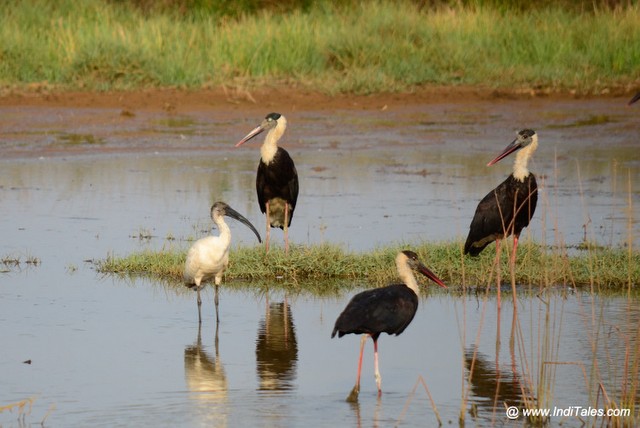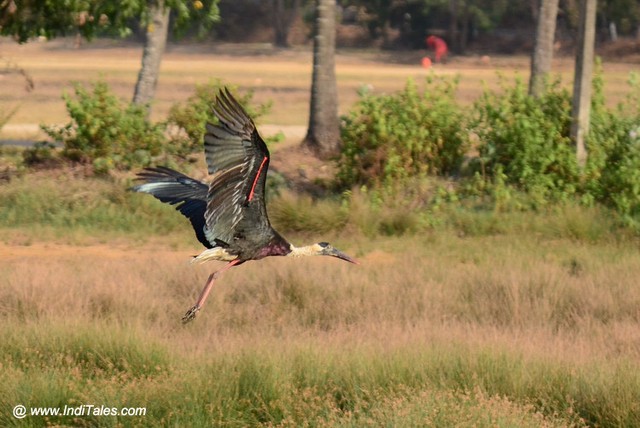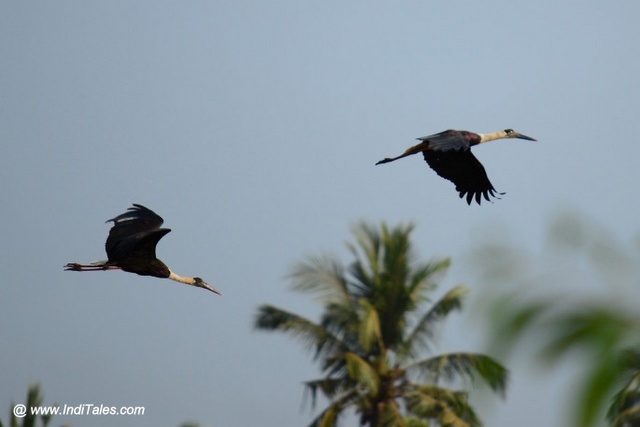A flock of Woolly-necked Stork birds by the shallow backwaters of Mandovi River near Merces village in Goa during the 2015 summer attracted our attention. As bird enthusiasts as they are often sighted solitary or in pairs by the wetlands like backwaters, marshes, rice fields, and floodplains here. This flock consisted of about 15 to 20 birds, which is a rare finding for us.
Being a fairly large bird, these birds were comfortable sharing this small water body with flocks of Lesser-whistling Ducks, Purple Swamphen & the Black-headed Ibis (Oriental White Ibis). Slowly wading through shallow waters looking for their prey.

They are so-called/named due to their wooly white neck and are also known by alternate names like Bishop Stork or White-necked Stork. It is called Shwethkanta Mahabak in Sanskrit. Its scientific name is Ciconia episcopus, race microscelis.
Stork Characteristics
Woolly-necked Stork is a large wading bird, approximately a meter in height with black-colored feathers. Its head and feathers are very interesting with a glistening bluish-purple pinkish color under the blazing sunlight, referred to as iridescence. The neck and underbelly are white, with long red legs and a mighty long sharp greyish-black bill with a reddish tip. Red eyes with the nictitating membrane.
The nictitating membrane is a transparent or translucent third eyelid. That can be drawn across the eye to protect and moisten it while maintaining visibility. You can see the opaque-looking eye in the bird behind Ibis in the below picture.

Reportedly both genders are similar in appearance & juveniles are duller lacking iridescence. The species is predominantly carnivorous, its diet consists of fish, frogs, toads, snakes, lizards, large insects, larvae, crabs, mollusks, and marine invertebrates.

Bird Flight
The Woolly-necked Stork is a broad-winged soaring bird, which relies on moving between thermals of hot air for sustained long-distance flight. Like all storks, it flies with its neck outstretched. As soon as disturbed its safety perimeter, quickly takes off only to circle over, scan the site, and return if it was a false alarm. They were seen soaring to heights above that of Kites/Eagles in the skies.
It was slowly circling to identify the preferred landing site and or fly away in search of new pastures. One of the largest high-flying birds, it is safe from the relatively smaller predatory eagles also circling in the skies looking for prey.

Birding Enthusiasts – Explore Goa Hinterlands
The IUCN lists them as vulnerable bird species. However, this widespread tropical species is found breeding from India to Indonesia to Africa. Declining habitat ie water bodies is attributed to the reduction in their numbers over a period of time. Goa has many backwater bodies and shallow marshlands that provide them an essential habitat. A matter of pride for a small state, home to several birds resident, and migratory.

It was a nice experience to watch a flock of these lovely birds while exploring the Goa hinterlands. Which is full of pleasant surprises for nature lovers and bird watchers. Birding in Goa can be a memorable experience for bird photography enthusiasts. Head for the hinterlands next time you visit and explore Goa beyond the beaches.
You may like to read my travel blog posts on birding & wildlife sanctuaries.














Nice pics…love Bird spotting and this is the perfect season for that. Have you been to Kokrebellur near Mysore? The place has some amazing migratory birds
Thanks Ami
Yes, heard of Kokrebellur, but yet to go there for birds. Goa gives us quite a good opportunity explore birds.
I never though that except beaches in Goa, there is anything else to watch. Great job done by you sharing a blog about Woolly-necked Stork cruising, i would love to see these kind of beautiful scenery when i will visit in Goa.
Hi Rohit, glad that you discovered a new aspect of Goa though Inditales. Goa is a paradise for bird watchers.
Nice article about WOOLLY-NECKED STORK FLOCK. Create more content like this